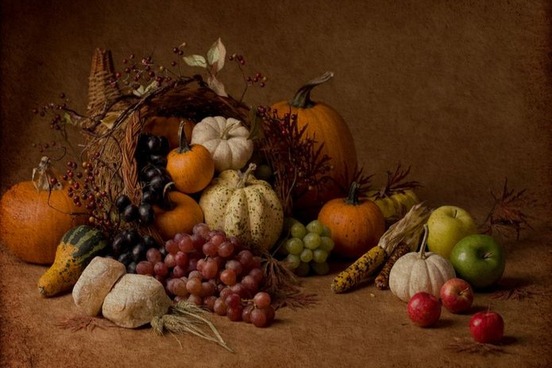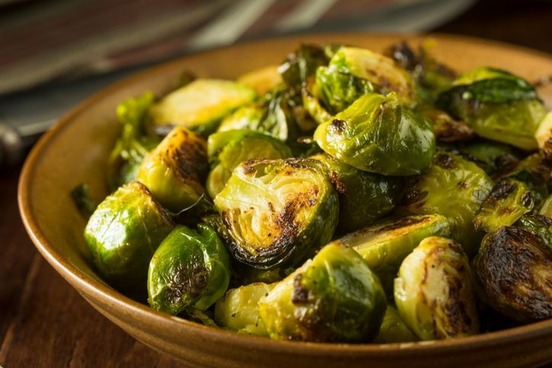
Cornucopia
A symbol of an abundant feast, the cornucopia is literally a horn of plenty, as it translates from the Latin cornu copiae. The first word of that Latin phrase serves as the root of such English words as cornada (“a wound inflicted by a bull's horn in formal bullfighting”), cornific (“producing horns”), and cornute (“to make a cuckold of”); the second part relates to our adjective copious (“yielding something abundantly”).
A better Cornucopia, then ever Nature (had shee beene true to their desires and wants) could have produced: the bread of Heaven, by which a man lives for ever.
— The devills banket, Thomas Adams, 1614

Kohlrabi
Kohlrabi took an interesting path to English by way of Italian and German. The vegetable’s Italian name, cavolo rapa, combines that language’s name for “cabbage” and “turnip.” The swollen stem of the kohlrabi plant resembles that of the turnip, even though the turnip is a root vegetable and the kohlrabi is a tuber. The plural form is kohlrabies.
Mr. Gibbs exhibited specimens of various pure and unmixed grass-seeds, of thousand-headed cabbage, kohl rabi, mangel-wurzel, turnips, &c.
— Universal Magazine (London, Eng.), Mar. 1809

Rutabaga
Invoking a linguistic history similar to that of kohlrabi, the rutabaga originated as the result of crossing a cabbage and a turnip. The word, however, derives from the Swedish words for “root” and “bag” (the latter suggesting the short, stumpy shape of the root). The rutabaga can also be known in the U.S. as a Swedish turnip or Swede.
It has been sold here by its Swedish name of Ruta Baga; and sometimes it is called Swedish turnip. Its appearance is not the most promising.
— The Bee (Edinburgh, Scot.), 22 Dec. 1790

Cauliflower
The cauliflower is another cabbage relative that indicates such in its name. In Italian the cauliflower is known as cavolfiore. Once again the Italian cavalo (“cabbage”) provides the first half of the word, along with fiore (“flower”), alluding to the white undeveloped flowers on its head. In non-gustatory use the word may be found in cauliflower ear (“an ear deformed from injury and excessive growth of reparative tissue”).
Take Wormewood, or Rew, and set it neere Lettuce, or Goleflory, or Artichoake; And see whether the Lettuce, or the Coleflory, &c. become not the sweeter.
— Francis Bacon, Sylva Sylvarum, 1627

Squash
The vegetable known as squash shares a homonym with both the name of a racquet sport and a verb meaning “to crush, flatten, or suppress.” Neither relates etymologically to the New World gourd, whose name derives from the Narragansett word askutasquash.
So for New-England, why should we thinke, that the Indian Corne, the Marsh-wheate, that excellent Rie, the Pease, (which never are eaten with magots) the French or Kidney Beanes, the Pumpions, Squashes, Water-Mellons, Musk-Mellons, Hurtleberries, wilde Hemp, Fir &c. of those parts, are altogether uselesse for us?
— Samuel Hartlib, An enlargement of the Discourse of husbandry used in Brabant and Flaunders, 1651

Pumpkin
Pumpkin is an alteration of an earlier word, pumpion, which can be traced ultimately to the Greek adjective pepon, meaning “ripened.” The English word pepo refers to the fruit of a gourd plant (a vine that encompasses pumpkins, squashes, cucumbers, and melons).
The seasonal flavoring known as pumpkin spice does not, in spite of its name, contain pumpkin. It’s a spice mix that generally contains those spices and herbs used in making pumpkin pie (such as cinnamon, nutmeg, ginger, cloves, and allspice).
Take your pumpkin, cut it into peeces, and seeth it with water and salt; after it is sod, straine it, and put it into a pot with an onion sticked with cloaves, fresh butter and peper; stove your bread, and if you will, allay three or foure yolks of eggs; and powre them over it with some broath, then serve.
— François Pierre de La Varenne, The French Cook, 1653

Broccoli
The green vegetable that we know as broccoli—the one that President George H. W. Bush hated—is native to the eastern Mediterranean and Asia Minor and found its way to the colonial-era United States. Broccoli is the plural of the Italian broccolo, meaning “flowering top of a cabbage,” the diminutive form of brocco, meaning “small nail, sprout.”
So does that make Broccolini a diminutive of a diminutive? Not exactly. That word, referring to a hybrid of broccoli and Chinese broccoli that has long, thin stems and yellow florets, was coined as a trademark.
The Method of Raising Cucumbers and Melons, Mushrooms, Borecole, Broccoli, Potatoes, and other curious and useful Plants, as practised in France, Italy, Holland, and Ireland.
— Stephen Switzer, The Practical Kitchen Gardiner, 1727

Brussels sprout
Although they are native to the Mediterranean region, Brussels sprouts are believed to have been grown in and around Belgium as early as 1200, which might explain their connection to the city of Brussels. It is useful to bear this etymology in mind when writing the word, as it may help in avoiding the common mistake of spelling it as Brussel sprout. The initial word may be found with either a capitalized or a lower case B; sprout is always written in lower case.
Related to the cabbage and cauliflower, the Brussels sprout plant is cultivated for its edible small roundish green buds, which grow on its stem and resemble miniature cabbages.
Brussels sprouts (somewhat perennial, producing numerous sprouts).
— John Abercrombie, The complete kitchen gardener, 1789

Parsnip
The parsnip is a relative of the carrot family with a whitish root. Its names derives from a Latin noun, pastinaca, which means “parsnip” or “carrot” and is related to pastinum, the name of a small gardening tool used to make holes in the ground for the insertion of plants, seeds, or bulbs. The fact that the name parsnip shares its last three letters with that of another edible root, turnip, may be due to the Middle English spelling of parsnip (passenep) having been influenced by nepe, the old form of turnip.
At the very first uncle-given dinner, after that dénouement, I can assure you, Mr. Editor, that I shall hate parsnips, take two glasses of port wine, tilt the dish for gravy, see Simpson and Co. at least six times, and read every novel in Lane’s Circulating List.
— Robert Rankin, The New Monthly Magazine (Boston, MA), 1 Jan. 1823

Yam
The edible tuber known as the yam often gets conflated with the sweet potato, the plant of which belongs to the morning-glory family. The tuberous root called the yam belongs to plants of the genus Dioscorea and grows mainly in tropical regions.
The label yam (deriving from Portuguese inhame & Spanish ñame) is sometimes mistakenly applied to what is actually a sweet potato, which has tapered ends and flesh of varying color.
Weeks and weeks ago our fresh provisions were all exhausted. There is not a sweet potato left; not a single yam.
— Herman Melville, Typee, 1846





